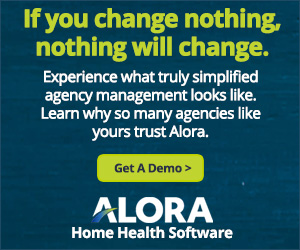
06 Feb Improving Home Health Billing, Payment and Care Coordination
An agency guide to best practices and solving logistical challenges
The moving parts of billing, payment, and care coordination within the home care environment are anything but a simple operation. Running a thriving home care agency is full of complex decision-making, and one could argue there are many logistical challenges. Top problems include those with billing, payment, and care coordination. The mitigation of these problems greatly promotes success within home care agencies and positive patient outcomes and experiences.
The Challenges
Billing & Payment
Muddling through billing and payment systems in home care? Not uncommon.
Problems in billing, often in the form of rejected or denied claims are robust and range from missing simple information (think dotted i’s or crossed t’s), mismatches in services and coding, or unpayable claims for services not covered by insurance benefits.
Manual entry of data leads to the unavoidable potential for inaccurate, incorrect, or missing information within documentation. The context surrounding billing problems can include:
- Disorganized systems for tracking and transferring incoming payments and outgoing claims.
- Misunderstandings of complex payor reimbursement models such as PDGM
- Keeping up to date on covered services under NCDs and LCDs
Payments for services, even when captured to the full extent, do not always reflect the value of care. Issues with payments for services in homecare include delayed, lost, or reduced reimbursement due to inaccurate capturing high quality care through payment models such as HHVBP.
The impacts of billing and payment issues can be costly, taking money away from other competing priorities within the home health agency. Capturing every dollar designated to reimbursement of services benefits all involved in the agency from aides to patients.
Care Coordination
You can’t do it alone.
Care coordination is not clearly defined, but can be seen as a system that helps patients and their caregivers navigate through the complex healthcare system. Information sharing and coordination is very complex and is often hard to manage. Misunderstandings in care coordination lead to team and patient frustration, wasted time, money, and resources, regulatory citations, and missed opportunities to improve patient health by closing gaps.
Both formal and informal communications contribute to care coordination. Root problems in care coordination include:
- Fragmentation in communication includes a lack of closed-loop communication or leaving out key participants in patient care.
- The use of an outdated home health EMR system may not enable the retrieval of patient care documents from outside agencies.
- Failing to assess basic patient needs prior to creating a plan of care leads to plans that are not patient-centered.
Solutions
Silos are for farms, not healthcare. Solutions focus on working together and the use of efficient systems.
A Team-Based Approach
The heavy lifting of care coordination often falls upon the nurse case manager to not only organize but also harmonize all aspects of patient care, patient needs, and health information shared amongst all team members. Involving patients and their loved one(s) as well as other disciplines involved in care is well known to drastically improve outcomes. A team-based, patient-centered approach better closes gaps in addressing the interrelated needs of the patient.
Regular Meetings
Understanding roles and responsibilities as well as scheduling regular care coordination meetings in person or online are an important part of working as a functional, organized team. Educating each person about their valued contributions about how to improve client care is essential and empowering to the process of care coordination.
Transfer Essential Information
Caring for patients, no matter the role, involves working with and transferring necessary information to those in need for the next level of care or need for client improvement. Care coordination is a team activity that includes the client and their designated caregiver(s) or loved ones. The availability of organized communication notes between patients, families, and caregivers supports the flow of necessary information for planning as well as backing up claims for services.
Checks and Balances
Team members still play a vital role in verifying patient insurance prior to care initiation as well as completing a final review of documents prior to submission. In advance of providing care, it is pertinent to check the basics of insurance coverage for a potential lapse in coverage, need for prior authorization, or out-of-network benefits. Before submitting claims, a team member with an eye for detail should review for commonly identified problems in denied or rejected claims (name, date of birth, MRN, physician, etc.) Though time intensive, these steps supply a safety net to home care agencies and are worth their cost.
The Right Technology
Pen and paper are nearly obsolete in the healthcare environment.
Streamlined technology systems including home health software with robust billing capability are widely available, as are mandated EVV systems that feature tracking and reporting of data from home healthcare visits. Resources that can capture multiple data points, including homecare visit verification and real-time documentation make coordination of care and billing easier.
Simplifying Care Documentation
Choosing the right technology for direct caregivers can drastically reduce issues with payments and billing by capturing accurate, timely information. Being able to transfer data simply within departments for compilation and review prior to being submitted for payment is essential for home care logistics. Simplifying the process of online or offline charting for homecare agencies to be available for front-line workers in real time promotes efficiency and reduces errors.
Support with Technology
Choosing a home care emr system with available support for both onboarding of the product as well as ongoing help for users is essential, especially given the staffing crisis and frequent turnover in home care agencies. Ease of use in addition to practical training guides available in multiple modalities will further promote a smooth transition from clunky logistics to a streamlined process.
Agencies work hard, as should their chosen homecare billing software for billing. Agencies rely heavily on their programs to capture correct and updated coding. With over 70,000 codes to choose from, who wouldn’t?
Technology is replacing much of the burden related to payments, billing, and care coordination in home care. With efficiency in these areas, positive patient experiences are more likely, as is a thriving agency.
Author’s Note: Views, information, and guidance in this resource are intended for information only. We are not rendering legal, financial, accounting, medical, or other professional advice. Alora disclaims any liability to any third party and cannot make any guarantee related to the content.
Other related blogs:
Maximizing Payments Under the Expanded HHVBP Model

Alora’s home health software solution is ideal for agencies operating in both skilled and non-skilled care. When it comes to scheduling, documentation, billing, and compliance Alora offers an award winning solution that simplifies the administrative processes in the agency back office, while making patient care a thing of joy. When everything you need for every aspect of homecare is in one place, workflow is easier and patients can receive the best care.




No Comments